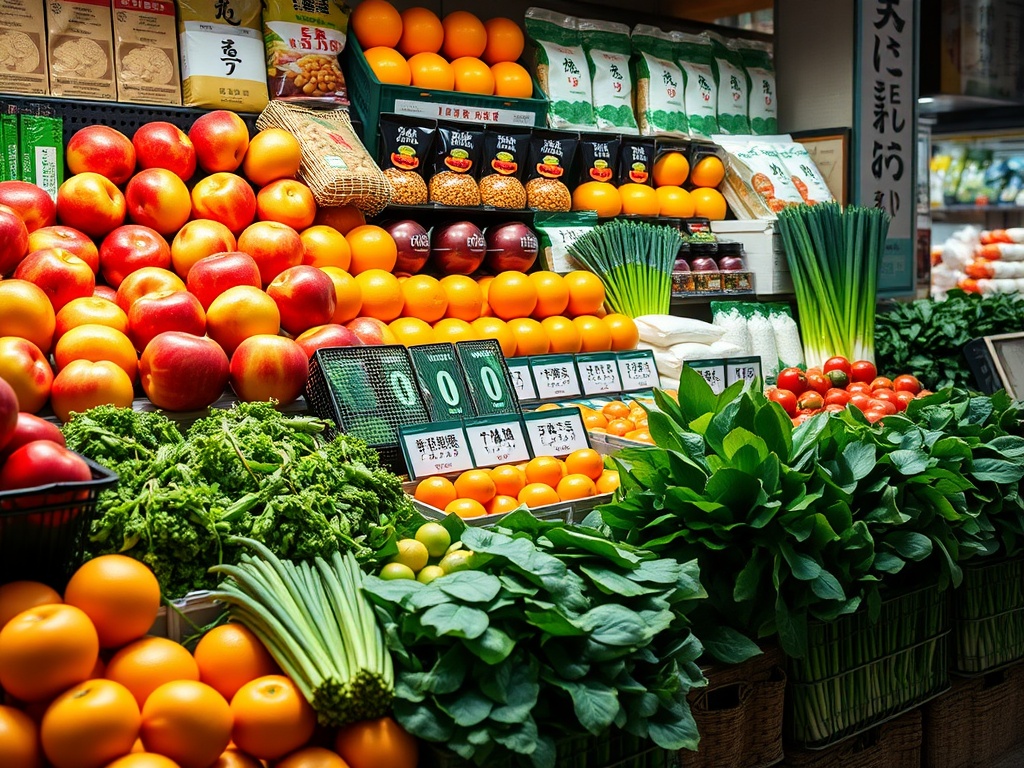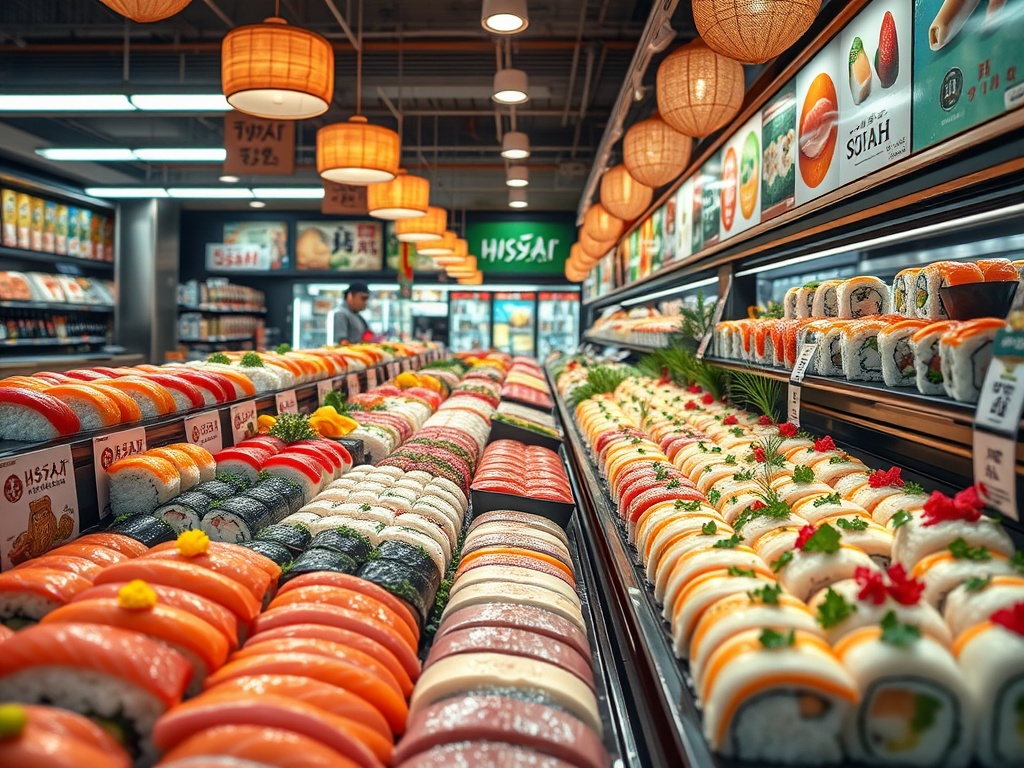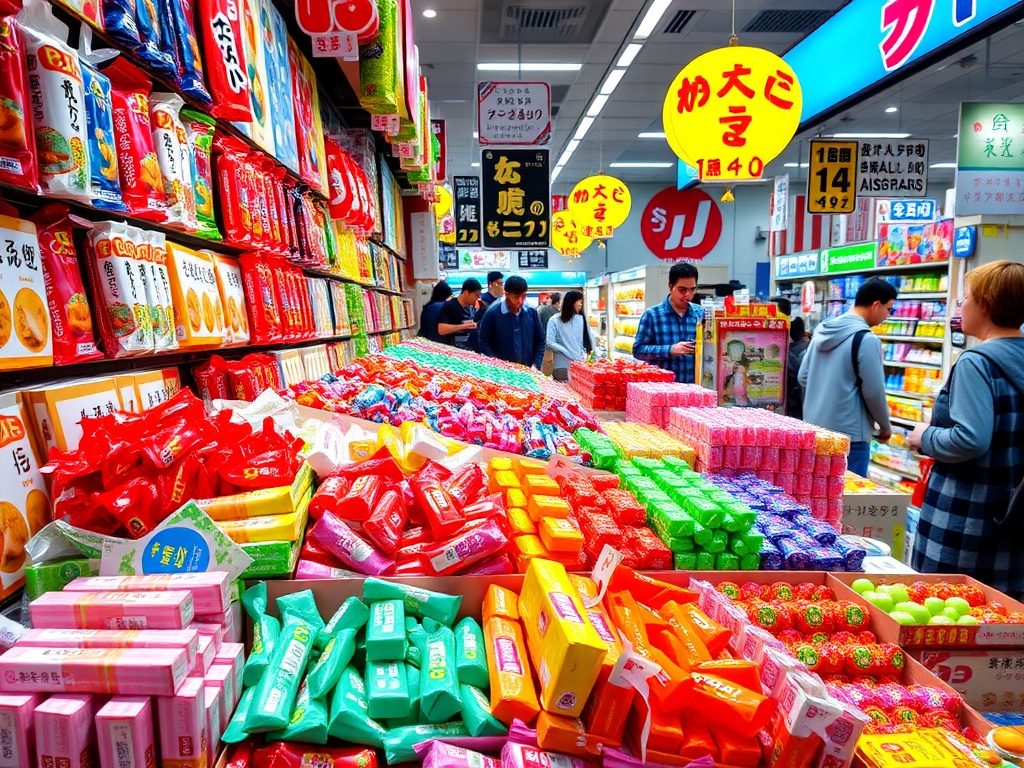Sushi Symphony: Discovering Tokyo’s Artful Fish Aisles
Win a Free Trip to Japan!
Experience cherry blossoms and ancient temples
Tokyo’s supermarkets are a feast for the senses, offering a kaleidoscope of colors, textures, and flavors that leave visitors in awe. Among the many treasures to be discovered, the sushi aisles stand out as a testament to the city’s dedication to culinary artistry. These aisles, brimming with carefully crafted sushi, are not just a place to shop but an experience that invites exploration and admiration.
Every sushi piece displayed in Tokyo’s supermarkets is more than just food; it is a masterpiece of the seafood world. From the delicate slices of sashimi to the intricately rolled maki, each item reflects the high standards of Japanese culinary tradition. As you wander through the aisles, you’ll notice the meticulous attention to detail, with each grain of rice and piece of fish placed with precision. This is sushi as an art form, where taste and aesthetics are given equal importance.
Tokyo’s supermarkets offer an impressive variety of sushi styles, each with its own unique charm. From the classic nigiri to the modern chirashi, there’s something to please every palate. The following list highlights some of the most popular sushi types you’ll encounter during your visit:
- Nigiri: A simple yet elegant combination of rice and fish, often garnished with wasabi.
- Maki: Rolled sushi, typically wrapped in seaweed, with a variety of fillings such as cucumber, tuna, or avocado.
- Temaki: A hand-rolled cone of seaweed filled with rice, fish, and vegetables.
- Chirashi: A colorful bowl of sushi rice topped with an assortment of sashimi and garnishes.
To truly appreciate the sushi symphony of Tokyo, it’s essential to enjoy it like a local. Here are some tips to enhance your sushi experience:
- Eat fresh: Always opt for sushi that is freshly prepared to savor the best flavors.
- Use soy sauce sparingly: A little goes a long way, and you don’t want to overpower the delicate taste of the fish.
- Try new varieties: Be adventurous and sample different types of sushi to discover your favorites.
Sweet Sensations: Tokyo’s Candy Wonderland Awaits
Tokyo’s supermarkets are not just about fresh produce and sushi; they are also a paradise for those with a sweet tooth. As you stroll through the vibrant aisles, you’ll be greeted by an array of candies and sweets that promise to transport you to a whimsical wonderland of flavors and colors.
Tokyo’s candy selections are as diverse as they are delicious, offering everything from traditional Japanese treats to modern innovations that will excite any traveler. The art of Japanese confectionery, or wagashi, is deeply rooted in the culture, and many of these sweets can be found in the charming candy sections of Tokyo’s supermarkets.
Wagashi Wonders
Wagashi are traditional Japanese sweets often enjoyed with tea. These delicacies are crafted with natural ingredients such as azuki bean paste, rice flour, and sweet potatoes. Their beautiful designs and subtle flavors make them a must-try for anyone visiting Tokyo.
In addition to traditional sweets, Tokyo’s supermarkets offer a plethora of modern candies that cater to all tastes. From quirky novelty candies to international favorites with a Japanese twist, there’s something for everyone to enjoy.
- Pocky: These iconic chocolate-coated biscuit sticks come in a variety of flavors, including matcha green tea, strawberry, and almond.
- Hi-Chew: A chewy, fruity candy available in a multitude of flavors, from classic grape to exotic lychee.
- KitKat: Japan is famous for its unique KitKat flavors, including wasabi, sake, and sweet potato, making them perfect souvenirs.
When navigating Tokyo’s candy wonderland, it’s helpful to know a few tips to make the most of your experience:
- Sample local specialties: Don’t miss out on trying regional sweets that are unique to certain areas of Japan.
- Gift-giving traditions: Consider buying beautifully packaged sweets as gifts for friends and family back home.
- Explore seasonal flavors: Many candies are offered in limited-edition flavors that reflect the changing seasons.
The Ramen Revolution: Savoring Instant Noodles Like Never Before
Tokyo’s supermarkets are a vibrant tapestry of culinary delights, each aisle offering a new adventure for the senses. Beyond the fresh produce and alluring sushi displays lies an equally enticing section dedicated to a beloved staple of Japanese cuisine: ramen. Here, the humble instant noodle is elevated to an art form, promising a quick yet deeply satisfying culinary experience that captivates both locals and travelers alike.
In Tokyo, instant noodles are not just a convenience food; they are a phenomenon that reflects the city’s passion for flavor and innovation. Supermarkets in Tokyo showcase a stunning array of ramen options, each packet a promise of a unique taste journey. From classic soy sauce and miso broths to adventurous flavors like tonkotsu and spicy seafood, the diversity is mesmerizing. These noodles are designed to deliver the essence of a traditional ramen shop experience in the comfort of your own home.
Transforming a simple packet of instant noodles into a gourmet meal is a delightful challenge embraced by many. Tokyo’s supermarkets provide all the ingredients needed to customize your ramen bowl, allowing you to add a personal touch. Fresh vegetables, marinated eggs, and tender slices of meat are just a few of the toppings available to elevate your noodle dish. The result is a culinary creation that is as much a feast for the eyes as it is for the palate.
For those eager to dive into the ramen revolution, a few tips can enhance the experience. Experiment with different brands and flavors to discover your personal favorite. Pay attention to cooking instructions, as each type of noodle may require a unique preparation method. Finally, consider pairing your ramen with a side of traditional Japanese pickles or a refreshing drink to balance the rich flavors.
Exploring the ramen aisles of Tokyo’s supermarkets is more than just shopping; it’s an invitation to immerse yourself in a culinary tradition that embraces creativity and taste. Whether you’re a seasoned noodle lover or a curious traveler, the ramen revolution offers an unforgettable taste of Tokyo’s vibrant food culture.
Matcha Marvels: Dive Into Tokyo’s Green Tea Paradise
Tokyo’s supermarkets are a treasure trove for food enthusiasts, offering a vibrant display of Japanese culinary delights that goes beyond mere sustenance. Among these offerings, the green tea aisles stand out as a haven for those who appreciate the rich flavors and cultural significance of matcha. Known for its vivid green hue and unique taste, matcha is more than just a beverage in Japan; it’s an integral part of the country’s heritage and a culinary experience that beckons exploration.
As you wander through the aisles of Tokyo’s supermarkets, you’ll be greeted by an impressive selection of matcha products. From traditional powdered tea to innovative matcha-infused snacks, these products reflect the artistry and dedication of Japanese tea culture. The aroma of finely ground tea leaves fills the air, inviting you to indulge in a sensory journey that is both calming and invigorating. Each product is a testament to the meticulous process of cultivating and grinding the highest quality tea leaves, ensuring a flavor profile that is both complex and refreshing.
While matcha is traditionally enjoyed as a hot beverage, its versatility has led to its incorporation into a wide range of culinary creations. In Tokyo’s supermarkets, you’ll find matcha in various forms, including sweets, noodles, and even skincare products. This versatility allows travelers to experience matcha in unexpected and delightful ways, providing a deeper appreciation for this iconic ingredient. Whether you’re savoring a matcha-flavored dessert or indulging in a matcha-infused beauty treatment, the possibilities are endless in Tokyo’s green tea paradise.
For those eager to bring a piece of Tokyo’s matcha magic back home, consider purchasing beautifully packaged matcha sets or locally made matcha treats. These items not only serve as perfect souvenirs but also as a reminder of the serene and harmonious essence of Japanese tea culture.
Exotic Elegance: Tokyo’s Rare Fruits and Vegetables
Tokyo’s supermarkets are a canvas of culinary wonders where every aisle offers a new discovery waiting to be made. Among these, the fruit and vegetable sections stand as a testament to Japan’s commitment to quality, beauty, and flavor. Here, you will find a dazzling array of rare and exquisite produce that transforms a simple grocery run into a journey of exploration and delight.
Wander the aisles, and you’ll encounter fruits and vegetables that are not only nourishing but also visually striking. These are not your everyday produce; they are meticulously cultivated treasures that reflect the artistry and precision of Japanese agriculture. From vibrant fruits with unique textures to vegetables that defy conventional appearances, Tokyo’s supermarkets boast a collection that is as impressive as it is delicious.
- Yubari Melon: Known for its unparalleled sweetness, this melon is often regarded as the pinnacle of luxury fruits.
- Shiso Leaves: With a flavor profile that combines mint, basil, and anise, these leaves add a unique zest to any dish.
- Wasabi Root: Fresh wasabi offers an authentic spice that is far superior to its processed counterparts.
- White Strawberries: These rare berries are not only a feast for the eyes but also offer a subtly sweet and fragrant taste.
For travelers and food enthusiasts, the chance to savor these rare fruits and vegetables is a culinary highlight. Each bite offers a taste of Japan’s rich agricultural heritage, where flavor, nutrition, and aesthetics are harmoniously balanced. When you select these items, you are not just purchasing food; you are embracing a piece of Tokyo’s cultural tapestry, woven with the threads of tradition and innovation.
Whether you’re creating a meal that showcases these unique ingredients or simply indulging in their natural form, the exotic elegance of Tokyo’s produce aisles promises an unforgettable culinary adventure.
Bento Box Bonanza: The Art of Japanese Lunches
In the bustling aisles of Tokyo’s supermarkets, an enticing symphony of flavors and visual delight awaits in the form of Japanese bento boxes. These meticulously crafted lunch boxes are a testament to the artful precision and dedication embedded in Japanese culinary culture. Venturing into the bento section is like embarking on a culinary journey, where each box unveils a miniature tapestry of taste and tradition, offering an insight into a meal that is as much about aesthetic pleasure as it is about nourishment.
Japanese bento boxes are renowned for their beautifully arranged compositions, where every element is thoughtfully placed to create a harmonious balance of color, texture, and flavor. More than just a meal, a bento is a reflection of the season, with ingredients chosen for their freshness and relevance to the time of year. From vibrant vegetables to delicately cooked meats and fragrant rice, each component is selected to complement the others, making every bento a unique culinary masterpiece. This attention to detail not only pleases the eye but also elevates the dining experience, allowing travelers to savor a taste of Japan’s rich cultural heritage in every bite.
For those visiting Tokyo, the bento aisle offers an opportunity to experience the joy of creating your own custom bento box. Supermarkets provide a diverse selection of components that you can mix and match to suit your palate. Whether you prefer the savory notes of teriyaki chicken, the umami richness of grilled fish, or the refreshing crunch of seasonal vegetables, the possibilities are endless. The act of assembling a bento becomes an immersive experience, where you can channel your inner chef and compose a meal that reflects your personal taste and culinary curiosity.
Moreover, bento boxes are not only a feast for the senses but also a convenient and satisfying option for travelers on the go. Perfectly portioned and neatly packed, they offer a practical solution for enjoying a delicious and nutritious meal while exploring the dynamic cityscape of Tokyo. As you unwrap your bento, you’ll discover that each layer reveals a new surprise, making it a delightful adventure for the taste buds.
Sake Soiree: Exploring Tokyo’s Traditional Rice Wines
Amidst the vibrant aisles of Tokyo’s supermarkets, a journey into the world of sake awaits. Known as Japan’s quintessential rice wine, sake is more than just a drink; it is a celebration of tradition, craftsmanship, and cultural heritage. For those with a penchant for discovering local flavors, the sake sections offer a glimpse into the heart of Japanese hospitality and culinary refinement.
As you explore Tokyo’s supermarket aisles dedicated to sake, you’ll find a diverse range of varieties, each telling its own story through flavor and aroma. From the delicate and floral junmai to the robust and full-bodied daiginjo, the selection is as vast as it is inviting. The art of sake brewing, honed over centuries, results in a beverage that is as complex as it is enjoyable, offering a tasting experience that is both enlightening and delightful.
To guide your exploration, here’s a brief overview of sake types you might encounter:
- Junmai: Pure rice sake, known for its rich and full-bodied flavor, often enjoyed warm.
- Ginjo: Brewed with highly polished rice, offering a light and fruity aroma, best served chilled.
- Daiginjo: The pinnacle of sake brewing, with an elegant and refined taste, ideal for special occasions.
- Honjozo: Slightly lighter in taste, often enhanced with a small amount of distilled alcohol for a crisp, clean finish.
To truly appreciate sake, consider pairing it with traditional Japanese dishes. The subtle nuances of sake complement the delicate flavors of sushi, enhance the umami in miso soup, and provide a harmonious balance to savory dishes like yakitori. Embrace the opportunity to learn from local experts who can offer insights into the best pairings and tasting techniques. Whether you’re a seasoned sake enthusiast or a curious traveler, the sake soiree in Tokyo’s supermarkets promises an unforgettable journey into the art of Japanese rice wine.
Seaweed Wonders: Unveiling the Secrets of Tokyo’s Ocean Delights
Tokyo’s supermarkets are a gateway to the extraordinary world of Japanese cuisine, where every aisle tells a story of flavor and tradition. Among these tales, the seaweed section emerges as a narrative of its own, weaving together the rich tapestry of the ocean’s bounty with the artful finesse of Japanese culinary mastery. For those eager to dive into the depths of Tokyo’s oceanic offerings, the seaweed aisles promise a journey that is both intriguing and delectable.
Seaweed, or nori as it’s commonly known, is more than just a sushi staple in Tokyo; it’s a versatile ingredient that embodies the essence of the sea. From the delicate sheets used to wrap sushi and onigiri to the robust varieties that find their way into soups and salads, seaweed is revered for its unique umami flavor and nutritional benefits. As you explore Tokyo’s supermarkets, you’ll discover a wide array of seaweed products, each with its own distinct characteristics and culinary uses.
For travelers keen on experiencing the breadth of seaweed’s culinary potential, here are some popular types you’ll encounter:
- Nori: Thin, dried sheets perfect for sushi rolls and garnishes.
- Kombu: A thick, flavorful kelp used as a base for dashi broth.
- Wakame: Often found in soups and salads, known for its tender texture.
- Hijiki: A dark, stringy seaweed with a slightly sweet and nutty flavor, ideal for salads and side dishes.
Tokyo’s supermarkets not only offer a variety of seaweed but also provide the inspiration to create your own seaweed-infused dishes. Whether you’re making a simple nori-wrapped rice ball or a sophisticated kombu-infused broth, the possibilities are endless. Embrace the chance to experiment with these oceanic treasures, and you’ll soon find that seaweed is an essential component of any culinary adventure in Tokyo.



